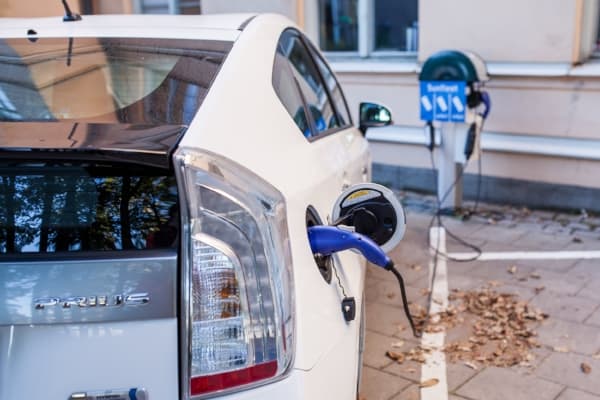
Yesterday, Toyota Motor Corporation and Panasonic Corporation held a joint press conference in Tokyo. Akio Toyoda unexpectedly disclosed the company’s target of selling about 4.5 million would be hybrids and plug-in hybrids. The remaining one million would be fully electric vehicles and fuel-cell vehicles by 2030 for a total of 5.5 million, or half of total projected sales.
Battery evolution is key
“To solve issues currently confronting us worldwide, such as global warming, air pollution, the depletion of natural resources and energy security, it will be necessary to further the popularization of electrified vehicles,” said Toyoda.
Both companies intend to broadly study concrete areas of collaboration from automotive prismatic lithium-ion batteries to next-generation batteries, such as solid-state, including procurement of the resources for such, all the way to reuse and recycling.
“The automotive industry is now facing an era of profound transformation, the likes of which come only once every 100 years,” said Toyoda. “No longer can we expect a future by adhering to our current path. We realize that we are now in an era in which we must create the future, using our wisdom and technology.”
Kazuhiro Tsuga, President, Panasonic Corporation, said, “The battery is a key device in promoting the widespread use of electrified vehicles, and thus toward achieving a sustainable society. This is why Panasonic positions the battery business as one of our primary businesses.”
Toyota gives Panasonic a new approach to collaboration. “We at Panasonic are strongly resolved to meet the expectations of Toyota Motor Corporation and to jointly study the feasibility of this plan in a speedy manner, with the aim of building a very practical business framework.”

Threat to Tesla?
The aim is for the companies to develop automotive prismatic batteries. Prismatic cells are grouped together in pouches to power electric cars. Most automakers are now pursuing prismatic cells over the type of cylindrical cells used by Tesla in its electric cars.
Tesla and Toyota were once collaborators until Toyota split with Tesla, believing the real direction was hydrogen vehicles. Tensions escalated after Elon Musk called fuel cells “mind-bogglingly stupid, “incredibly dumb,” and “fool cells.”
For the sake of Tesla and the forthcoming Semi, prepping preorders, and setting to release by late 2019, one hopes there really is no conflict.
While Panasonic has been the major battery supplier to Tesla, the deal is not exclusive. In fact, Tesla recently opened a “mega” battery plant in South Australia, and will be working in coordination there with Samsung.
Is the recent Panasonic play with Toyota a response?
Whatever the case, the deal with Panasonic shows that Toyota increasingly accepts EV technology. Toyota’s battery needs are likely to increase after it said last year it would add fully electric vehicles to its product line-up in the early 2020s, expanding a green-car strategy which has, until recently, focused on plug-in hybrid and fuel-cell vehicles (FCV).
Wall Street Journal reports Toyota’s hybrid vehicles, combining an electric motor and a gasoline engine, already made up about 14% of sales in 2016. Those vehicles are included in Toyota’s target for 2030, as well as plug-in hybrids that can draw electricity from a power outlet, fuel-cell vehicles and fully electric vehicles.
But who is on the fastest path to the “game-changer” battery is still anyone’s guess.
Others joining the industry changes
Volkswagen also announced in November it planned to invest around $40 billion over the next five years to develop electric vehicles, self-driving cars and Uber-like mobility-app services. Honda Motor Co. said in February 2016 that hybrid, fully electric and fuel-cell vehicles would account for two-thirds of its global sales by 2030. Volvo plans to sell only electric or hybrid vehicles by 2019.
While these announcements are sending ripple effects across the industry, it would seem to fall right in line with Morgan Stanley’s On the Charge report from earlier this fall, projecting “one billion EVs by 2050.” The bottom line is regulatory oversight is accelerating much faster than once anticipated.
Impact across the sector
As Adam Jonas, Morgan Stanley’s head of global auto & shared mobility research, says in a follow up to the MS report, “A confluence of competitive, technological and regulatory forces have pulled-forward auto maker’s plans to aggressively introduce EVs over the next 3 to 5 years vs. 20 to 25 years previously.”
The path involves hundreds of billions of dollars of capital investment across the sector stack including autos, commodities, cap goods and the supporting infrastructure.
As sales of electric vehicles ramp up, so will the need for a spectrum of metals that are used to make everything from batteries to wiring, some investors say.
According to Wall Street Journal, the automotive demand for lithium is set to climb 35% each year through 2021, according to Citigroup Inc. projections. Morgan Stanley anticipates Cobalt used in electric vehicles will increase roughly 450% from this year to 2025. Electric vehicles will become the second-largest nickel-consuming sector by that year, with demand rising nearly 10-fold, while copper demand for cars and infrastructure is also expected to grow steadily, a JPMorgan Chase forecast showed.
Stay up-to-date with the latest commentary and insights on FreightTech and the impact to the markets by subscribing.











